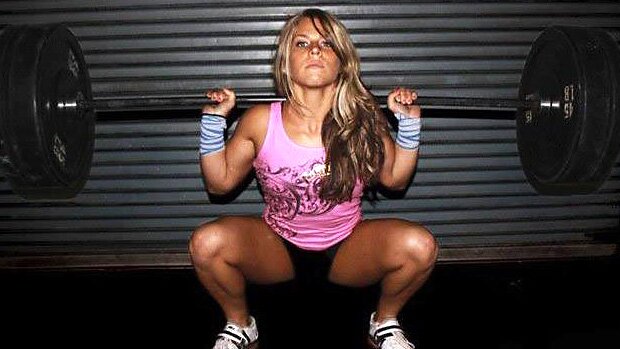Is Full or Deep Squatting Bad for Our Knees?
An Educated Decision

With a growing interest in progressive resistance exercise, we are seeing an equally growing body of research aimed at understanding the effects of exercise variation on our body’s structures (muscles, joints, bones, ligaments, cartilage). Whether the goal of progressive resistance exercise is to gain muscle mass, improve strength/power, lose body weight or increase general fitness, the squat is one of the most effective exercises in training.
It has been suggested that full or deep squatting can lead to increased injury of the knees. To clarify, the half squat is performed with knee angles at 80°-100° and the full or deep squat at 40°-45°. Unfortunately, this suggestion does not take into a number of influences that work to protect the knees with increased squat depth. These influences include a wrapping effect around the knee, functional adaptations and soft tissue contact between the back of thigh and calf when squatting below half range.
Hartmann et al. (2013) published a review in Sports Medicine that examined over 164 articles published between 2011-2013 and found there are no realistic estimations of increased knee-joint forces for knee-flexion angles beyond 50° in the deep squat. Also, based on biomechanical calculations and measurements of cadaver knee joints, the highest compressive forces and stresses on the knees can actually be seen at 90°, indicating that greater stresses on the knee occur when half squatting not full squatting!
Another reason deep squatting is safe for our knees is that with increased knee flexion beyond 90°, it has been suggested that a “wrapping effect” occurs, whereby the additional contact between the quadriceps (thigh muscle) tendon and the intercondylar notch (the groove between the two rounded ends of the thighbone) contributes to an enhanced load distribution and force transfer. Therefore, a lower risk of injury in the deep squat position can be expected.
When deep squatting, there is also a reduction in shear forces on the knees, specifically the anterior cruciate ligament (ACL). Multiple authors have demonstrated that, in cadaver knees, opposing hamstring load and quadriceps load minimized shear forces on the knees by limiting tibiofemoral translation (movement of the shin bone over the thigh bone) and as a result reduced tensile forces on the ACL.
Also, the influence of soft tissue contact between the back of the thigh and the calf muscle plays a significant role in reducing the knee-joint forces beyond 40° of knee extension. This soft tissue contact has been shown to reduce tibiofemoral and patellofemoral joint forces in deep squatting range.
Furthermore, the adaptation potential of ligaments is well established from training studies. For example, training has been shown to increase tensile strength and enhance stiffness and elasticity of the ACL knee ligament. Grzelak et al. (2012) demonstrated significantly larger ACL cross-sectional area of young weightlifters compared with age matched controls. The cross-sectional area of the ACL and posterior collateral ligament (PCL) of these weightlifters were found to be 50% and 61.49% larger than those of the cadaver studies. Given this, continual squatting at depth would gradually increase the tensile strength, and hence lower risk of injury of these knee structures.
Finally, if one argues that knee problems occur in those populations who frequently perform deep squats, it could be reasonable to suggest that international weightlifting athletes are predisposed to a high prevalence of acute and chronic knee injuries with long training interruptions.
However, Calhoon et al. (1999) studied 27 weightlifters from different US Olympic training centres and showed that only 3.3 injuries occurred per 1000 training hours over a 6-year period. Of missed training time due to knee problems, 95.3 % lasted 1 day or less, and in the remaining cases, lasted less than 1 week. Also, these training interruptions were primarily related to tendinitis due to chronic overuse and in very few cases to muscle strains due to acute injuries. These findings were echoed by Lavallee et al. (2010) in a 4-year retrospective study that found of 1,109 weightlifters (age 12–20 years) that participated in national or international competitions, zero showed any injuries (i.e. at the knee joints) that required surgery or hospitalization.
Moral of the story: Full or deep squatting is not bad for our knees.
References:
Cabaud HE, Chatty A, Gildengorin V, et al. Exercise effects on the strength of the rat anterior cruciate ligament. Am J Sports Med. 1980;8:79–86.
Calhoon G, Fry AC. Injury rates and profiles of elite competitive weightlifters. J Athl Train. 1999;34:232–8.
Grzelak P, Podgorski M, Stefanczyk L, et al. Hypertrophied cruciate ligament in high performance weightlifters observed in magnetic resonance imaging. Int Orthop. 2012;36:1715–9.
Hartmann H, Wirth K, Klusemann M. Analysis of the Load on the Knee Joint and Vertebral Column with Changes in Squatting Depth and Weight Load. Sports Med. 2013;43:993-1008.
Lavallee ME, Balam T. An overview of strength training injuries: acute and chronic. Curr Sports Med Rep. 2010;9:307–13.
Noyes RF, Grood ES. The strength of the anterior cruciate ligament in humans and rhesus monkeys. J Bone Joint Surg. 1976;58-A:1074–82.
Race A, Amis AA. The mechanical properties of the two bundles of the human posterior cruciate ligament. J Biomech. 1994;27:13–24.